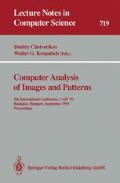Abstract
We present a framework for contour fragment grouping. The contour fragments extracted from an image by an appropriate edge-detection procedure are assumed to be attributed with an estimate of brightness contrast. Based on this brightness contrast along detected contour fragments, we reconstruct a smooth (weak membrane) intensity function under the boundary conditions imposed by the contour fragments. This reconstructed intensity function subsequently serves as a potential field φ in a framework of different possible contour grouping processes. In this paper we treat the general problem of grouping two straight line contour fragments building an arbitrary (missing) angle. We solve the grouping problem in closed form a specific grouping process within the suggested framework.
Preview
Unable to display preview. Download preview PDF.
Literature
References
K.Ottenberg, A Framework for Contour Grouping via Brightness Contrast Diffusion, submitted to CVGIP:Image Understanding.
A. Blake and A. Zisserman, Visual Reconstruction; The MIT Press, Cambridge, 1987.
D. Terzopoulos, The role of constraints and discontinuities in visible — surface reconstruction, in Proceedings 8th International Joint Conference on Artificial Intelligence, Karlsruhe, Germany, August 1983, pp. 1073–1077.
D. Terzopoulos, Regularization of Inverse Visual Problems Involving Discontinuities, IEEE Transactions on Pattern Analysis and machine Intelligence, 8(4), 1986, pp.413–424.
D. Terzopoulos, The Computation of Visible Surface Representations, IEEE Transactions on Pattern Analysis and machine Intelligence, 10(4), 1988, pp.417–438.
D. Geiger and F. Girosi, Parallel and Deterministic Algorithms for MRFs: Surface Reconstruction, IEEE Transactions on Pattern Analysis and Machine Intelligence, 13(5), 1991, pp. 401–412.
N. Nordstroem, Biased Anisotropic Diffusion — A Unified Regularization and Diffusion Approach to Edge Detection, Image and Vision Computing, 8(4), 1990, pp.318–327.
D. Geiger and A. Yuille, A Common Framework for Image Segmentation, International Journal of Computer Vision, 6(3), 1991, pp. 227–243.
C. Caratheodory, Conformal Representation, Cambridge, 1932.
Author information
Authors and Affiliations
Editor information
Rights and permissions
Copyright information
© 1993 Springer-Verlag Berlin Heidelberg
About this paper
Cite this paper
Ottenberg, K. (1993). Brightness-contrast diffusion and the grouping of missing angles. In: Chetverikov, D., Kropatsch, W.G. (eds) Computer Analysis of Images and Patterns. CAIP 1993. Lecture Notes in Computer Science, vol 719. Springer, Berlin, Heidelberg. https://doi.org/10.1007/3-540-57233-3_18
Download citation
DOI: https://doi.org/10.1007/3-540-57233-3_18
Published:
Publisher Name: Springer, Berlin, Heidelberg
Print ISBN: 978-3-540-57233-6
Online ISBN: 978-3-540-47980-2
eBook Packages: Springer Book Archive

